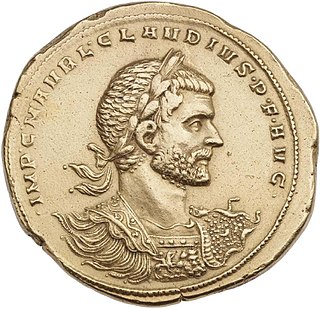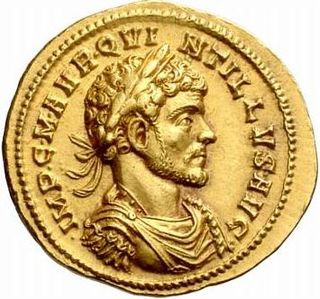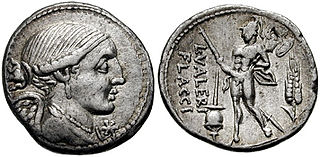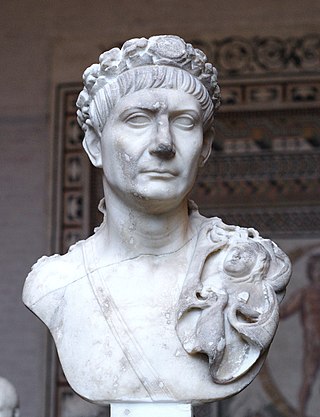Related Research Articles

Marcus Aurelius Claudius "Gothicus", also known as Claudius II, was Roman emperor from 268 to 270. During his reign he fought successfully against the Alemanni and decisively defeated the Goths at the Battle of Naissus. He died after succumbing to a "pestilence", possibly the Plague of Cyprian that had ravaged the provinces of the Empire.

Marcus Aurelius Claudius Quintillus was a short-lived Roman emperor. He was a brother of Emperor Claudius Gothicus, whom he succeeded after Claudius' death in 270. Quintillus' claim to be emperor was challenged by Aurelian, who was proclaimed emperor by the legions he commanded. Quintillus' reign only lasted a few weeks. Different sources report his cause of death as murder by his own soldiers, in battle with Aurelian, or by suicide.

The gens Valeria was a patrician family at ancient Rome, prominent from the very beginning of the Republic to the latest period of the Empire. Publius Valerius Poplicola was one of the consuls in 509 BC, the year that saw the overthrow of the Tarquins, and the members of his family were among the most celebrated statesmen and generals at the beginning of the Republic. Over the next ten centuries, few gentes produced as many distinguished men, and at every period the name of Valerius was constantly to be found in the lists of annual magistrates, and held in the highest honour. Several of the emperors claimed descent from the Valerii, whose name they bore as part of their official nomenclature.

Marcus Cassianius Latinius Postumus was a Roman commander of Batavian origin, who ruled as emperor of the splinter state of the Roman Empire known to modern historians as the Gallic Empire. The Roman army in Gaul threw off its allegiance to Gallienus around the year 260, and Postumus assumed the title and powers of Emperor in the provinces of Gaul, Germania, Britannia, and Hispania. He ruled for the better part of ten years before he was murdered by his own troops.
Sextus Aurelius Victor was a historian and politician of the Roman Empire. Victor was the author of a short history of imperial Rome, entitled De Caesaribus and covering the period from Augustus to Constantius II. The work was published in 361. Under the emperor Julian (361-363), Victor served as governor of Pannonia Secunda; in 389 he became praefectus urbi, senior imperial official in Rome.

The gens Aurelia was a plebeian family at ancient Rome, which flourished from the third century BC to the latest period of the Empire. The first of the Aurelian gens to obtain the consulship was Gaius Aurelius Cotta in 252 BC. From then to the end of the Republic, the Aurelii supplied many distinguished statesmen, before entering a period of relative obscurity under the early emperors. In the latter part of the first century, a family of the Aurelii rose to prominence, obtaining patrician status, and eventually the throne itself. A series of emperors belonged to this family, through birth or adoption, including Marcus Aurelius and the members of the Severan dynasty.
Eutropius was a Roman official and historian. His book Breviarium Historiae Romanae summarizes events from the founding of Rome in the 8th century BC down to the author's lifetime. Appreciated by later generations for its clear presentation and writing style, the Breviarium can be used as a supplement to more comprehensive Roman historical texts that have survived in fragmentary condition.

De Viris Illustribus, meaning "concerning illustrious men", represents a genre of literature which evolved during the Italian Renaissance in imitation of the exemplary literature of Ancient Rome. It inspired the widespread commissioning of groups of matching portraits of famous men from history to serve as moral role models.

Dacia Ripensis was the name of a Roman province in the northern Balkan peninsula, immediately south of the Middle Danube. Its capital was Ratiaria. It was a district less urban than neighbouring Dacia Mediterranea and more militarized; "military camps and forts, rather than cities, were typical of the province". Besides Ratiaria, Oescus was the major settlement.

Festus was a Late Roman historian. His name appears in some manuscripts as Rufius Festus, Rufus Festus, Sextus Rufus or Sextus Festus, but they appear to be corruptions. He is mainly known as the author of an epitome titled Breviarium rerum gestarum populi Romani, written around AD 370 and commissioned by the Eastern emperor Valens in preparation for his war against Persia. The Breviarium covers the entire history of the Roman state from the foundation of the city. The book consists of 30 chapters treating Roman events in a terse overview, mainly focused on military and political conflicts. It is estimated to be a work of very low quality.

Andreas Schott was an academic, linguist, translator, editor and a Jesuit priest from Antwerp in the Habsburg Netherlands. He was mainly known for his editions of Latin and Greek classical literature.
The Epitome de Caesaribus is a 5th-century Latin historical work based on the Liber de Caesaribus by Aurelius Victor.

Charles François Lhomond was a French priest, grammarian, and educator who was a native of Chaulnes, Somme.

The gens Ulpia was a Roman family that rose to prominence during the first century AD. The gens is best known from the emperor Marcus Ulpius Trajanus, who reigned from AD 98 to 117. The Thirtieth Legion took its name, Ulpia, in his honor. The city of Serdica, modern day Sofia, was renamed as Ulpia Serdica.

The topography of ancient Rome is the description of the built environment of the city of ancient Rome. It is a multidisciplinary field of study that draws on archaeology, epigraphy, cartography and philology. The word 'topography' here has its older sense of a description of a place, now often considered to be local history, rather than its usual modern meaning, the study of landforms.
The gens Messia was a plebeian family at Rome. The first person of this name to appear in history is Vettius Messius, a Volscian soldier whose courage inspired his comrades in a desperate battle against the Romans in 431 BC. It is not known when the Messii first obtained Roman citizenship. Members of the family appear in the lists of annual magistrates during the final decades of the Republic. In imperial times, some of the Messii achieved the highest offices of the Roman state.
The gens Ogulnia was an ancient plebeian family at ancient Rome. The gens first came to prominence at the beginning of the third century BC, when the brothers Quintus and Gnaeus Ogulnius, tribunes of the plebs, carried a law opening most of the Roman priesthoods to the plebeians. The only member of the family to obtain the consulship was Quintus Ogulnius Gallus in 269 BC. However, Ogulnii are still found in imperial times.
The gens Opellia, also spelled Opelia and Opilia, was a minor family of imperial Rome, which briefly emerged from obscurity when Marcus Opellius Macrinus was proclaimed emperor following the murder of Caracalla in AD 217. The only members of this gens who appear in history are the emperor and his son, Marcus Opellius Diadumenianus, who ruled briefly as co-emperor in 218, but other Opellii are found in inscriptions, particularly from Dacia.
Kleine und fragmentarische Historiker der Spätantike, or ‘Minor and Fragmentary Historians of Late Antiquity’, is an edition of Greek and Latin historiographical texts from Late Antiquity.
The anonymous work De viris illustribus urbis Romae is the only work in Latin literature to offer an outline of Roman history in the form of 86 short biographies from the founding of the city to the Principate of Augustus. Contrary to what the title suggests, however, not only famous commanders and politicians are included, but also illustrious female figures and outstanding enemies of Rome. There is no discernible difference between Romans and non-Romans or positive and negative figures. In terms of type and structure, the writing fits best into the context of the late antique breviaries of the 4th century, so that a writing in the 4th century seems plausible.
References
- Alexander Enmann, Eine verlorene geschichte der römischen Kaiser und das buch de viris illustribus urbis romae. Philologus, no. Supplement-Band 4, Heft 3. (1884). p. 337-501.
- Bleckmann, Bruno; Nickbakht, Mehran A.; Scardino, Carlo (2022). Enmannsche Kaisergeschichte. Rufius Festus, Breviarium. Kleine und fragmentarische Historiker der Spätantike. Vol. B1/B4. Paderborn: Brill Schöningh. pp. 3–216. ISBN 978-3-506-70832-8.
- Willem den Boer, Some Minor Roman Historians. Leiden, 1972.
- Timothy David Barnes, The Sources of the Historia Augusta. Collection Latomus v. 155. Bruxelles: Latomus, 1978.
- Burgess, R. W. (1995). "On the Date of the Kaisergeschichte". Classical Philology. 90 (2): 111–128. doi:10.1086/367453. JSTOR 270485. S2CID 162872345. (with bibliography).